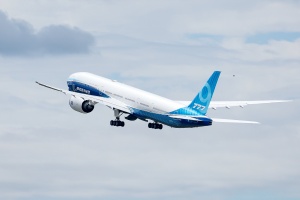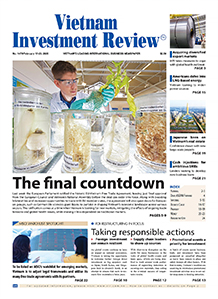Vietnam expected to double air traffic over next 10 years
 |
| Dave Schulte, Boeing's managing director in Asia-Pacific, at the press conference on April 24 |
With passenger air traffic in Southeast Asia projected to grow more than 7 per cent annually, Vietnam remains central to this growth with annual expansion of over 8 per cent, the highest rate across the region.
Air traffic in Vietnam is expected to double over the next 10 years, growing to more than 75 million annual passengers, the report said. The number of passengers travelling to, from, and within Vietnam is expected to double over the next decade. Of this, the top markets to and from Vietnam will be South Korea, China, Thailand, Taiwan, Malaysia, Singapore, and Japan.
Asia-Pacific airlines account for 35 per cent of global air cargo traffic. Of this, Vietnam air cargo is expected to see a 350 per cent increase in export value per tonne over the next decade, and 10 per cent annual e-commerce growth.
Southeast Asia’s air cargo market is likely to need more than 120 freighters by 2043, the outlook noted.
Aviation contributes significantly to Vietnam’s economy, including 2.5 million jobs and $18 billion in GDP contributions, by direct, indirect, induced ways, and tourism.
New aeroplanes will deliver an immediate boost to the country’s connectivity and economic growth. Airlines across Southeast Asia will need 4,720 new planes over the next 20 years, with single-aisle jets comprising 80 per cent of projected deliveries, the outlook reported.
The wider Asia-Pacific region will account for approximately one-third of global freighter deliveries through 2043.
Boeing provides more than 90 per cent of worldwide dedicated freighter capacity, including new production and converted planes.
The projected rise in aeroplane demand will also increase the need for aviation industry talent like pilots, engineers, and ground personnel, creating jobs in Vietnam and the Southeast Asia region. Southeast Asia operators are expected to need to hire and train 234,000 new pilots, maintenance technicians, and cabin crew, more than tripling the region’s active personnel.
 |
2025 marks Boeing’s 30th year of partnership with Vietnam, which began in 1995 when Vietnam Airlines leased three Boeing 767-300ERs. The first business transaction between Vietnam and the US, under a historic bilateral trade agreement, was Vietnam Airlines’ purchase of four Boeing 777-200ERs in 2001.
Vietnam Airlines currently operates 11 Boeing 787-9s and 6 787-10s, serving international routes between Vietnam and Europe, as well as domestic and regional routes. In 2023, Vietnam Airlines signed a proposal to purchase 50 Boeing 737 MAX planes.
Vietjet, a privately held airline currently holding the largest market share in Vietnam, has 200 737 MAX aircraft on order to support its growth plans in Asia.
Today, Boeing’s presence in Vietnam covers commercial aviation, defence, supply chain, technical training, university collaborations, and community impact initiatives. Boeing has a corporate office in Hanoi, along with field service offices in both Hanoi and Ho Chi Minh City.
 | Boeing forecasts 2.4 million demand for worldwide airline personnel over next 20 years Over the next 20 years, Boeing projects significant demand for aviation personnel as the global commercial aeroplane fleet continues to expand. |
 | Southeast Asia primed to play key role in growth of sustainable aviation fuel industry Southeast Asia's feedstocks can supply approximately 12 per cent of global sustainable aviation fuel (SAF) demand to meet the commercial aviation industry's net-zero goal by 2050, according to a report developed by Roundtable on Sustainable Biomaterials (RSB) and supported by Boeing released on September 3. |
 | Boeing urged to explore more investment opportunities in Vietnam Vietnam's Party General Secretary and President To Lam has urged Boeing to explore investment opportunities in Vietnam, specifically in establishing aircraft component manufacturing facilities and a regional-scale maintenance centre connected to the country’s major airports. |
What the stars mean:
★ Poor ★ ★ Promising ★★★ Good ★★★★ Very good ★★★★★ Exceptional
Related Contents
Latest News
More News
- The destinations powering Vietnam’s festive season travel demand (December 04, 2025 | 18:33)
- Vietnam named among the world’s most exciting winter destinations (December 04, 2025 | 15:10)
- Phu Tho emerges as northern Vietnam’s new tourism hub (December 01, 2025 | 17:00)
- Vietjet completes Airbus A320/A321 updates ahead of deadline (December 01, 2025 | 09:49)
- Vietjet resumes Con Dao flights from early December (November 28, 2025 | 15:24)
- Free tickets, Lunar New Year promotions on offer at Vietjet Mega Livestream (November 26, 2025 | 15:32)
- Scandinavian Airlines and Vietnam Airlines broaden agreement with new routes (November 25, 2025 | 17:04)
- Halong Cruise Port welcomes over 3,100 international visitors (November 12, 2025 | 18:06)
- Vietnam.travel climbs to second place in Southeast Asia website rankings (November 12, 2025 | 18:01)
- Cat Ba named among Southeast Asia’s top island adventures (November 11, 2025 | 18:09)

 Tag:
Tag:




























 Mobile Version
Mobile Version